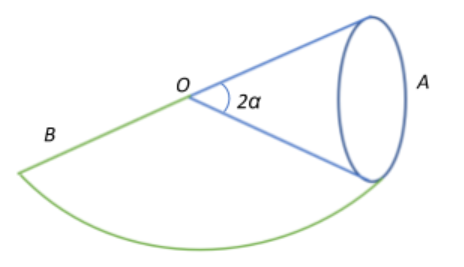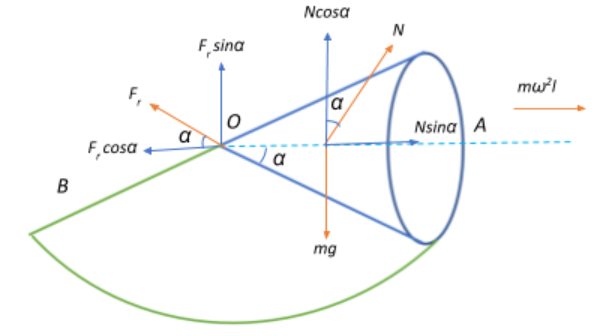
A round cone A of mass


Answer
491.7k+ views
Hint: Begin by listing out all the forces that influence the state of rest and motion of the cone. In other words, we have the gravitational force, corresponding normal reaction force, centrifugal force as a result of the fixed apex and moving base of the cone, and the frictional force between the cone A and the surface B. Resolve the forces into their directional components.
At equilibrium determine the expressions for the net force in the horizontal and vertical directions. Rearrange the equations to suitably arrive at an expression for the static frictional force, following which you can substitute the given parameter values to obtain the appropriate result.
Formula used: Gravitational force
Centrifugal force
Complete step by step answer:
We are given that the mass of the cone
The conical half-angle
The cone moves around the surface B in such a way that the apex O remains fixed at its initial position.
Let us begin by accounting for all influencing forces and resolving them into their corresponding directional components.
The cone possesses mass, and consequently experiences a gravitational force due to the gravitational acceleration acting on the cone by virtue of its placement on the conical surface B. In response to this gravitational force directed downwards, the surface B exerts a reaction force directed normally upwards, passing through the centre of gravity of the cone.
We resolve this normal reaction into its directional components in order to deduce the component of this normal reaction force that balances out the gravitational force since the effective normal reaction is not geometrically aligned with the gravitational force.
Then we have the frictional force that acts along the lateral surface of the cone, between the cone and the surface B as shown in the figure. This frictional force can also be resolved into respective directional components since it acts in a direction inclined with the axis of the cone. Thus, the angle that this force makes with the axis of the cone is geometrically equivalent to the half-angle of the cone.

Finally, we have the centrifugal force that the cone is subjected to as a result of having its apex fixed in position while the base moves about this point over the surface B. If the cone possesses a tangential velocity v as it traces an angular path about its centre of gravity at a distance
Since the cone undergoes an angular motion about the conical surface B, the angular velocity with which it traverses the path can be given as
From the free body diagram that we’ve thus obtained we can now determine the force equations at equilibrium.
We have along the vertical axis:
And along the horizontal axis we get:
Substituting for N that we derived earlier:
Solving for
Since
Substituting
Therefore, the static friction force is found to be
Note: Recall that we take the length of the cone as the radius along which the centrifugal force acts since it is along this axis of the cone with the fixed apex that the cone executes its rolling motion.
Also, remember that it is always helpful to resolve the influencing forces into their components as this will give us a clear picture of which forces contribute in which direction. Failure to do this will result in inconsistent or variably estimated results since we end up accounting for the non-influencing forces or the ones that may in fact, cancel each other out
While resolving the forces into their horizontal and vertical components, remember to assign the
The correct way to go about this would be to establish that the component that is adjacent to
At equilibrium determine the expressions for the net force in the horizontal and vertical directions. Rearrange the equations to suitably arrive at an expression for the static frictional force, following which you can substitute the given parameter values to obtain the appropriate result.
Formula used: Gravitational force
Centrifugal force
Complete step by step answer:
We are given that the mass of the cone
The conical half-angle
The cone moves around the surface B in such a way that the apex O remains fixed at its initial position.
Let us begin by accounting for all influencing forces and resolving them into their corresponding directional components.
The cone possesses mass, and consequently experiences a gravitational force due to the gravitational acceleration acting on the cone by virtue of its placement on the conical surface B. In response to this gravitational force directed downwards, the surface B exerts a reaction force directed normally upwards, passing through the centre of gravity of the cone.
We resolve this normal reaction into its directional components in order to deduce the component of this normal reaction force that balances out the gravitational force since the effective normal reaction is not geometrically aligned with the gravitational force.
Then we have the frictional force that acts along the lateral surface of the cone, between the cone and the surface B as shown in the figure. This frictional force can also be resolved into respective directional components since it acts in a direction inclined with the axis of the cone. Thus, the angle that this force makes with the axis of the cone is geometrically equivalent to the half-angle of the cone.

Finally, we have the centrifugal force that the cone is subjected to as a result of having its apex fixed in position while the base moves about this point over the surface B. If the cone possesses a tangential velocity v as it traces an angular path about its centre of gravity at a distance
Since the cone undergoes an angular motion about the conical surface B, the angular velocity with which it traverses the path can be given as
From the free body diagram that we’ve thus obtained we can now determine the force equations at equilibrium.
We have along the vertical axis:
And along the horizontal axis we get:
Substituting for N that we derived earlier:
Solving for
Since
Substituting
Therefore, the static friction force is found to be
Note: Recall that we take the length of the cone as the radius along which the centrifugal force acts since it is along this axis of the cone with the fixed apex that the cone executes its rolling motion.
Also, remember that it is always helpful to resolve the influencing forces into their components as this will give us a clear picture of which forces contribute in which direction. Failure to do this will result in inconsistent or variably estimated results since we end up accounting for the non-influencing forces or the ones that may in fact, cancel each other out
While resolving the forces into their horizontal and vertical components, remember to assign the
The correct way to go about this would be to establish that the component that is adjacent to
Recently Updated Pages
Master Class 11 English: Engaging Questions & Answers for Success

Master Class 11 Computer Science: Engaging Questions & Answers for Success

Master Class 11 Maths: Engaging Questions & Answers for Success

Master Class 11 Social Science: Engaging Questions & Answers for Success

Master Class 11 Physics: Engaging Questions & Answers for Success

Master Class 11 Chemistry: Engaging Questions & Answers for Success

Trending doubts
State and prove Bernoullis theorem class 11 physics CBSE

1 ton equals to A 100 kg B 1000 kg C 10 kg D 10000 class 11 physics CBSE

State the laws of reflection of light

One Metric ton is equal to kg A 10000 B 1000 C 100 class 11 physics CBSE

Difference Between Prokaryotic Cells and Eukaryotic Cells

1 Quintal is equal to a 110 kg b 10 kg c 100kg d 1000 class 11 physics CBSE




